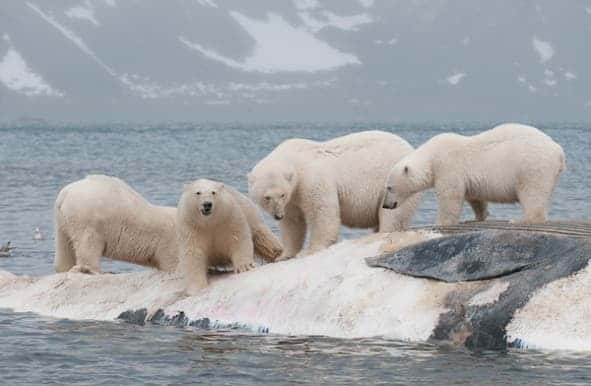After carefully calculating the net nutritional gain polar bears have from land-based food like caribou, berries or bird eggs, researchers found this is far from enough to compensate their typical fat-rich diet based on marine mammals. In consequence, as ice retreats and spring hunting season shortens polar bear populations are expected to fall dramatically. According to the study, two-third of the world’s polar bears will disappear by mid-century and by the end of the century the could follow, if the issue is not addressed.

Arctic sea ice has seen a sharp decline over the past four decades, as the sea ice cover is shrinking and thinning, making scientists think an ice-free Arctic Ocean during the summer might be reached this century. Ice grows dramatically each winter, usually reaching its maximum in March. It melts just as dramatically each summer, generally reaching its minimum in September. But since 1979 when satellite observations came into operation, this sea ice has been regularly thinning year in, year out. Since 2002, ice extent at the summer minimum has not returned to anything approaching the long-term average (1979-2000).
Despite sea ice has fluctuated, natural cycles alone like the Arctic Oscillation aren’t enough to explain the steep decline. Instead, most scientists argue that natural variability and greenhouse gas emissions (and the resulting rise in global temperatures) likely worked together to melt greater amounts of Arctic sea ice. The table below put together by NASA summarizes Arctic ice loss since 1979.
| September/March (minimum/maximum) | September Average Extent (millions of square kilometers) | March Average Extent (millions of square kilometers) |
|---|---|---|
| 1979–2000 mean | 7.0 | 15.7 |
| 1999/2000 | 6.2 | 15.3 |
| 2000/2001 | 6.3 | 15.6 |
| 2001/2002 | 6.8 | 15.4 |
| 2002/2003 | 6.0 | 15.5 |
| 2003/2004 | 6.2 | 15.1 |
| 2004/2005 | 6.1 | 14.7 |
| 2005/2006 | 5.6 | 14.4 |
| 2006/2007 | 5.9 | 14.7 |
| 2007/2008 | 4.3 | 15.2 |
| 2008/2009 | 4.7 | 15.1 |
| 2009/2010 | 5.4 | 15.1 |
| 2010/2011 | 4.9 | 14.6 |
| 2011/2012 | 4.6 | 15.2 |
| 2012/2013 | 3.6 | 15.1 |
| 2013/2014 | 5.4 | 14.8 |
During summer, polar bears spend of their time on land. It’s in Winter than they get to munch on their favorite food (seals), but because the ice has been thinning the winter their land stints have been getting ever frequent. Because a handful of sightings have been reported of polar bears snacking on land-based food, some biologists argued that the polar bears would compensate this way for the seal meat. A team at the US Geological Survey (USGS) found that this would be insufficient, however. The bears put in too much energy searching for berries or chasing down caribou, so the net nutritional gain is far from enough to keep them fed.
“Current evidence suggests it is unlikely terrestrial foods can make up for the calories polar bears lose out on in places where they are staying onshore longer than they have in the past,” said study author Karyn Rode, a wildlife biologist at the USGS. “In western Hudson Bay, during years when polar bears spend more time onshore and the ice-free period is longest, survival rates are lowest despite observed terrestrial feeding.”
“A really large bear has high energetic costs when they get up to forage, and these [terrestrial] resources are typically lower in calories or widely dispersed,” said Rode.
It’s not just that it’s not worth it for the bears to forage land food, there’s simply not enough to spare. On land, polar bears compete for food with Arctic Grizzlies, who also struggle to find food. The study, published in Frontiers in Ecology and the Environment, also notes that all the goose eggs in Canada’s Hudson Bay could maintain the 900 local polar bears for just a day and a half. This would mean a dramatic loss to the local ecosystem.


